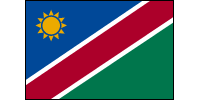| Country (long form) |
Republic of Namibia |
| Capital |
Windhoek |
| Total Area |
318,695.67 sq mi
825,418.00 sq km
(slightly more than half the size of Alaska) |
| Population |
1,797,677 (July 2001 est.)
note: estimates for this country explicitly take into account the effects of excess mortality due to AIDS; this can result in lower life expectancy, higher infant mortality and death rates, lower population and growth rates, and changes in the distribution of population by age and sex than would otherwise be expected |
| Estimated Population in 2050 |
2,464,890 |
| Languages |
English 7% (official), Afrikaans common language of most of the population and about 60% of the white population, German 32%, indigenous languages: Oshivambo, Herero, Nama |
| Literacy |
38.0% total, 45.0% male, 31% female (1960 est.) |
| Religions |
Christian 80% to 90% (Lutheran 50% at least), indigenous beliefs 10% to 20% |
| Life Expectancy |
42.48 male, 38.71 female (2001 est.) |
| Government Type |
republic |
| Currency |
1 Namibian dollar (N$) = 100 cents |
| GDP (per capita) |
$4,300 (2000 est.) |
| Industry |
meat packing, fish processing, dairy products; mining (diamond, lead, zinc, tin, silver, tungsten, uranium, copper) |
| Agriculture |
millet, sorghum, peanuts; livestock; fish |
| Arable Land |
1% |
| Natural Resources |
diamonds, copper, uranium, gold, lead, tin, lithium, cadmium, zinc, salt, vanadium, natural gas, hydropower, fish |
|


|